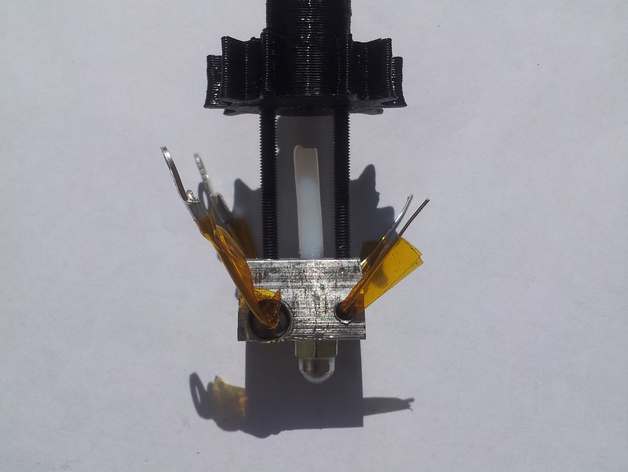
Printed Template Hotend, MkII
thingiverse
NOTE: I highly recommend you use version 3. I have found the M4 nut does not provide an adequate grip on the Bowden cable. In certain configurations this causes the M4 nut to slip off after a period of time, reducing the life of the hotend. I made a hotend you can drill from a template. Print out the template, wrap it around a metal rod, and drill where you see the holes. The design uses a Bowden cable as an isolator, so only the metal part requires drilling. Detailed instructions can be found here. Adapters are available for both jhead and huxley-style mounts. The huxley-style adapter includes an optional fan mount, and can also be used to make an all metal variant. To make the all-metal variant, simply switch out the teflon tube with a m4 screw that's been hollowed out by a 2mm drill bit. This variant requires the use of a fan. Updates Version 2 of the hotend decouples the nozzle from the heat block. An M4 acorn nut serves as the nozzle. The bowden cable screws in firmly through the heat block before entering the acorn nut. This is done for several reasons: Tapering is already afforded by the acorn nut. Filing metal is no longer needed. Square rods can be used for the heat block, making it easier to drill holes accurately The interface for the bowden cable no longer needs to be drilled to a precise depth - all holes in the design can be made as through-holes Nozzles of different diameter can be easily swapped out to suit the needs of the print. Already I've tried this design on 0.3mm, 0.5mm, and 0.8mm nozzle diameters. A 0.8mm nozzle diameter is very forgiving and lets you print big, strong objects very fast, while a 0.3mm is needed if you want to print very fine detail. Instructions Bill of Materials 1/2" aluminum square rod Acorn nut, size M4 or 8-32 Machine screws, size M3 or 4-40 Teflon Bowden cable, 2mm ID, 4mm OD Honeywell 100K Thermistor 5.6 or 6.8 Ohm vitreous resistor Tools Drill Taps for making size M3 (4-40) and M4 (8-32) threads Hacksaw Assembly Download and print "heatblock_template.stl". Wrap the print out around a 1/2" metal rod or metric equivalent. I prefer aluminum - it's cheap, easy to drill, and it conducts heat well. Drill anywhere you see a hole. You'll want the finished piece to match the diagram, below. The size of your drill bit should roughly fit the size of the hole. Check the table for recommended bit sizes. Using a tap, cut the threads into the holes that run through the top of the heat block. Again, check the table above for recommended tap sizes. Now, take a hacksaw and cut off your piece from the metal rod. There's a groove in the template that's meant for this purpose. Insert the heat resistor, thermistor, and Bowden cable. The Bowden cable should go all the way through the heat block and leave a few millimeters available on the other end. This will provide something with which we can attach the acorn nut. Drill a small (0.1-1mm) hole through an M4 (8-32) acorn nut. A dremel works best for large nozzles. Smaller nozzles may require a jeweler's drill. Screw the acorn nut onto Bowden cable. How you mount your hotend will depend on your setup. Printable adapters are provided for Jhead and Huxley style mounts. Print out whichever is most appropriate and attach it to the heat block using two long (>50mm) M3 (4-40) screws or threaded rods. I prefer stainless steel threaded rod due to its length and low thermal conductivity. These screws will also serve to secure the electronic components you inserted from earlier. the teflon tubing you installed earlier should pass through the center of the adapter and hook up with the bowden cable coupler (not shown in image below). This will allow you to easily attach and detach your hotend to the bowden cable.
With this file you will be able to print Printed Template Hotend, MkII with your 3D printer. Click on the button and save the file on your computer to work, edit or customize your design. You can also find more 3D designs for printers on Printed Template Hotend, MkII.
